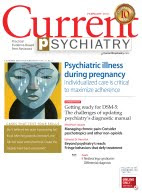Thursday, May 6, 2010
Antidepressants in bipolar disorder
Joseph F. Goldberg, MD Associate clinical professor, Department of psychiatry, Mount Sinai School of Medicine, New York, NY, Affective Disorders Research Program, Silver Hill Hospital, New Canaan, CT
Few topics are as controversial as the role of antidepressants for patients with bipolar disorder. Although depression usually is the predominant, most enduring mood state in bipolar disorder, clinicians often face uncertainty about using antidepressants because of concerns about safety and efficacy. Whether and when to use antidepressants for bipolar depression hinges on complex parameters that preclude any single, simple rule.
Rather than asking if antidepressants are useful or detrimental for depressed patients with bipolar disorder, a more practical question might be: Under what circumstances are antidepressants likely to be beneficial, deleterious, or ineffective for an individual patient? Because “real world” patients often have idiosyncrasies that defy practice guidelines’ generic treatment recommendations, clinicians who practice in the proverbial trenches need strategies to tailor treatments to each patient that are informed—but not dictated—by evidence-based research.
Read full text (free access)
Comment on this article
Email the editor
Women's response to antidepressants
Wendy K. Marsh, MD, Assistant professor, Department of psychiatry, University of Massachusetts Medical School, Worcester, MA
Kristina M. Deligiannidis, MD, Assistant professor of psychiatry, Director, Depression Specialty Clinic, Center for Psychopharmacologic Research and Treatment, University of Massachusetts Medical School, Worcester, MA
Both men and women respond well to antidepressants, yet there are notable differences between the 2. Understanding why men and women may differ in response to antidepressants helps clinicians better tailor their treatment choice and dosing.
This article outlines some of differences—and lack thereof—in response rates to antidepressants. Our discussion of why these differences may occur is framed in the context of pharmacokinetics, pharmacodynamics, and the influence of gonadal hormones on antidepressant-related neurotransmitter systems. The second section focuses on major reproductive phases of adult women (the menstrual cycle, pregnancy, postpartum, and menopause) and how antidepressant response rates can influence clinical decision making, such as antidepressant timing, dose, and choice of potential adjunct treatments.
Read full text (free access)
Comment on this article
Email the editor
Kristina M. Deligiannidis, MD, Assistant professor of psychiatry, Director, Depression Specialty Clinic, Center for Psychopharmacologic Research and Treatment, University of Massachusetts Medical School, Worcester, MA
Both men and women respond well to antidepressants, yet there are notable differences between the 2. Understanding why men and women may differ in response to antidepressants helps clinicians better tailor their treatment choice and dosing.
This article outlines some of differences—and lack thereof—in response rates to antidepressants. Our discussion of why these differences may occur is framed in the context of pharmacokinetics, pharmacodynamics, and the influence of gonadal hormones on antidepressant-related neurotransmitter systems. The second section focuses on major reproductive phases of adult women (the menstrual cycle, pregnancy, postpartum, and menopause) and how antidepressant response rates can influence clinical decision making, such as antidepressant timing, dose, and choice of potential adjunct treatments.
Read full text (free access)
Comment on this article
Email the editor
Combination therapy is here to stay
 Henry A. Nasrallah, MD
Henry A. Nasrallah, MDEditor-in-Chief
Although psychiatrists commonly combine psychotropic medications, researchers malign the practice as “not evidence-based.” Research is finally catching up with clinical practice, however, and evidence is rapidly accumulating that for many patients with severe psychiatric disorders, 2 drugs are better than 1.
This should not be surprising because “real world” patients with schizophrenia, bipolar disorder, major depression, anxiety disorders, or obsessive-compulsive disorder (OCD) often do not achieve remission and are hobbled—even disabled—by their illness without combination therapy. The same principle holds true for general medical illnesses such as hypertension, cancer, or diabetes, where combination therapy is the norm rather than the exception.
Recent studies have confirmed better efficacy with combination therapy compared with monotherapy for several psychiatric illnesses.
Subscribe to:
Posts (Atom)

